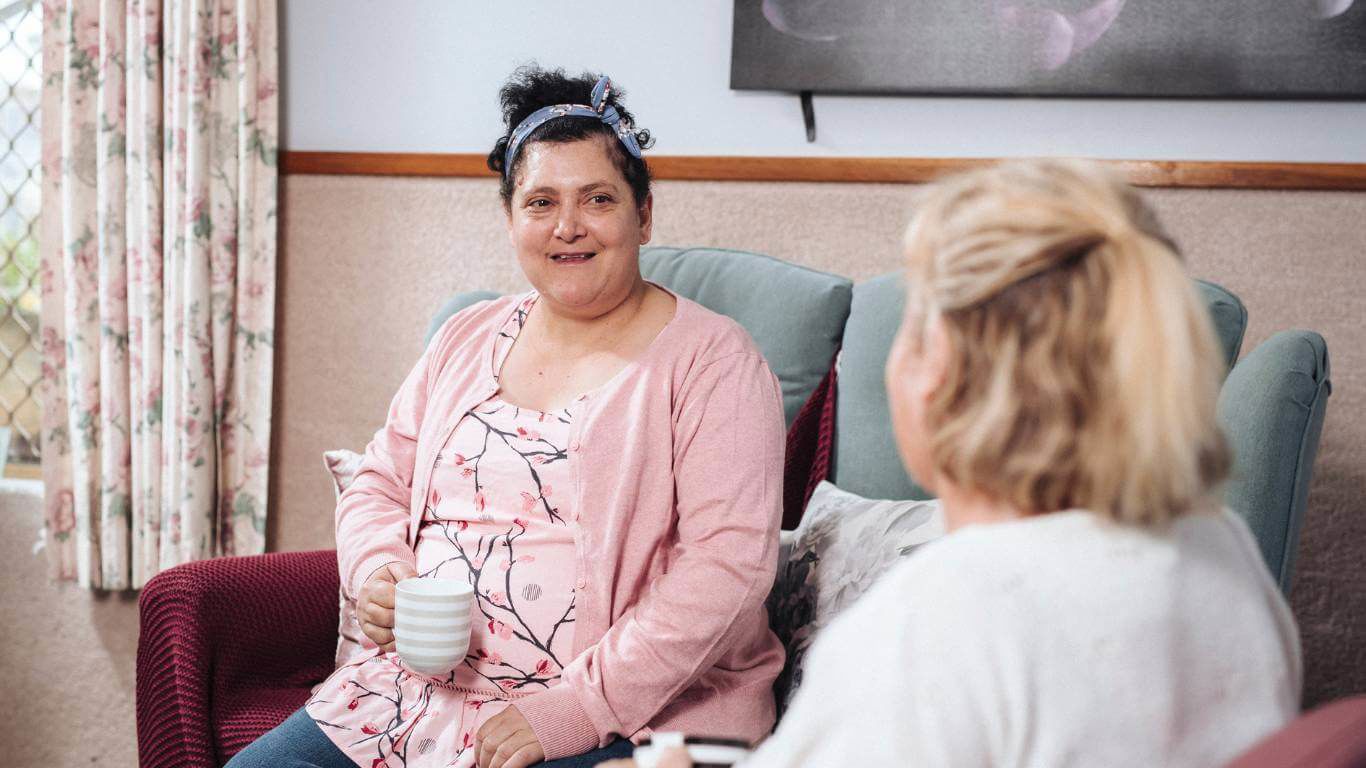People living with a disability can have cognitive and communication challenges which make it difficult for them to articulate what they are feeling. As a result, they rely on physical behaviour as one way to express themselves.
This can result in challenging behaviours* that negatively affect the quality of life of the individual and the people caring for them. These behaviours often get in the way of the person participating well in their own life and in the community.
“If I could teach anyone one thing about Positive Behaviour Support, it is that all behaviour is a form of communication,” says Brightwater Positive Behaviour Support Practitioner Claire Goodlet. “Too often, a challenging behaviour gets labelled as ‘negative’ behaviour, and it is our role to look at what the person is trying to communicate and put strategies in place to help address their unmet needs.”
Through a holistic, person-centred approach, Positive Behaviour Support can reduce behaviours of concern and improve wellbeing.
“People need three things to thrive – to be competent, to have autonomy over their lives and to feel that they belong and are connected to others,” explains Ms Goodlet. “People living with a disability often miss out on these three things. They no longer have the resources to do what they used to do before the diagnosis. Their autonomy is gone because they are told what to wear and when to eat, and they have lost connection to others. Yet they need these three things just as much as anybody else does. That’s why Positive Behaviour Support is so important.”
This article looks at the key components of a Positive Behaviour Support Plan, how to access a Positive Behaviour Support Plan through the NDIS and the benefits that can come from engaging Positive Behaviour Support.

What is a Positive Behaviour Support Plan?
A Positive Behaviour Support Plan is a type of behaviour management plan that aims to reduce challenging behaviours and the use of restrictive practices.
A Positive Behaviour Support Plan seeks to look below the surface; to dig deeper and get to know the person behind the diagnosis. This contrasts with traditional behaviour management plans, where challenging behaviours are seen as something to be managed and not addressed on a deeper level. Traditional behaviour management plans are often reactive and focus on consequences for behaviour, rather than being proactive and seeking to create an environment that encourages more positive behaviours.
Challenging behaviours are often a result of the person having unmet needs.
A Positive Behaviour Support Plan seeks to determine what those unmet needs are and either bring a team together to meet those needs or help the individual to meet those needs themselves. Positive Behaviour Support Plans are tailored to each individual and can be adjusted over time.
“Often there are challenging behaviours present and no behaviour management plan in place,” explains Claire. “Once engaged, we take the time to understand all facets of a person and the impact their diagnosis has on their behaviour. We also look at what support they have in place and the environment they exist in. In doing this, we can start to work out the meaning of their behaviour and reduce the stress they are feeling.”
Physical aggression is the most challenging type of behaviour and can be a sign that the person is at the end of their tether. A Positive Behaviour Support framework will uncover the unseen things going on for an individual that is causing them to be distressed.
A Positive Behaviour Support Plan will also take into account the perspective of family and friends. “Most people aren’t being disruptive for no reason. We develop a good relationship with their support people as they can help us determine what is going on for the person.”
It is important to note that behaviour change is a slow process.
Positive Behaviour Support practitioners are often engaged when individuals or their supports are at their wits end and have run out of options or are now in crisis. While it is understandable to hope for a ‘quick fix’, behaviour change is a long-term goal that takes time.

How To Use Your NDIS Funding For Positive Behaviour Support
To access NDIS funding for a Positive Behaviour Support Plan, a Support Coordinator or NDIS Planner must demonstrate there are behaviours of concern that are impacting on quality of life or that restrictive practices are in place.
If restrictive practices exist, it is mandatory for the person to have a comprehensive Positive Behavioural Support Plan. The plan must outline what positive behaviour support strategies are being implemented to eliminate the use of restrictive practices (or, if they can’t be fully eliminated, to ensure the least restrictive practices are utilised.)
Positive Behaviour Support is accessed via the ‘Improved Relationships’ budget under the ‘Capacity Building’ category of a participant’s NDIS Plan. PBS services are unable to be billed from Core Supports. You can find out more about the NDIS here.
How to choose a Positive Behaviour Support Practitioner
Positive Behaviour Support Practitioners should possess a wealth of knowledge and work across multiple disciplines to create the best outcome for the client. A quality Positive Behaviour Support Practitioner will always champion a person-centered, collaborative approach.
Brightwater’s team of Positive Behaviour Support practitioners come from a diverse background including speech pathology, social work and psychology, creating a vast knowledge and experience bank for the team to draw upon.
“There is a lot of overlap in what we do,” says Brightwater Positive Behavioural Support Practitioner Claire Goodlet. “We cross a lot of disciplines to make sure that a person’s entire support team is working to support the positive behaviour management strategies in place.
“For example, if a client finds it very traumatic to be lifted in a hoist, we devise a collaborative plan with their physiotherapist, support staff, family members and the person themselves so we can all work together to deliver a more positive experience. We support each other, share information and work very hard!”
Key Components of a Behaviour Support Plan
There is no ‘one size fits all’ for Positive Behaviour Support Plans. Each plan is guided by the individual and their unique story.
That said, there is a general process that the Positive Behaviour Support practitioner will follow, addressing the following main components:
- Assessment: The practitioner will get to know the individual, learning about their history, diagnosis and other facets of their abilities.
- Behaviour identification: What are the behaviours of concern? Are any restrictive practices in place that need to be reported?
- Reasons for behaviour: The practitioner will work closely with the person and their support system (family, friends, care staff) to determine why certain behaviours are occurring and what triggers them.
- Risk identification: Does the person pose a risk to themselves and / or to others?
- Goal setting: Setting goals for positive behaviour that optimise a person’s strengths.
- Strategy implementation: Positive behaviour management strategies are developed and shared with the greater support team to ensure maximum benefit.
If restrictive practices are in place, an Interim Behaviour Support Plan will be required as a ‘stop gap’ measure before a more comprehensive plan can be developed. An interim plan is a brief, temporary measure that focuses on keeping the individual and others safe until a more comprehensive plan can be developed.
All Positive Behaviour Support frameworks are regularly reviewed to assess what is working and what may need adjusting.

Benefits of Positive Behaviour Support for People with Disabilities
The greatest benefit experienced from Positive Behaviour Support is an improved quality of life. Once the root cause of the challenging behaviour has been determined, positive behaviour support strategies and changes can be implemented to put the person on a path where stress is reduced, emotional wellbeing is supported and positive behaviours are encouraged.
Reducing challenging behaviours has benefits for both the individual and their support network. “We assess the impact of positive behavioural support plans through regular assessments,” said Claire Goodlet, Brightwater Positive Behaviour Support practitioner. “For example, we have a client who was exhibiting aggressive behaviour around five times a day, and through altering his environment and educating the people around him, it has come down to once a day.”
Additional benefits include better relationships, the empowerment of families and the individual, and an increased sense of fulfillment and wellness in the person.
Brightwater client Shaun* lives with complex disabilities and receives Positive Behaviour Support. He says, “I used to have to fight, but I don’t fight anymore. I am happy when I am quiet and doing my beading and drawing.” Shaun wished to reconnect with his family who live 1500km away and his Positive Behaviour Support practitioner is facilitating this process. “I miss my family, but I got help to speak to my mum and sister on the phone the other day,” said Shaun.
Get In Touch With Us
Our NDIS-registered Positive Behaviour Support practitioners are currently helping to reduce challenging behaviours and improve lives across Perth.
With a diverse wealth of knowledge and a person-centered approach, our Positive Behaviour Support practitioners enjoy strong relationships with clients and their families, creating a supportive environment that improves quality of life for all.
We encourage you to find out more about Brightwater’s Positive Behaviour Support here (link to Positive Behaviour Support Services Perth | NDIS | Brightwater)
*You may have heard of other ways to describe challenging behaviours. Alternate terminology includes ‘behaviours of concern’ or ‘behavioural difficulties.’



